Spiny McSpleen's Nifty
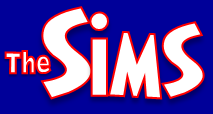
WEBPAGE
The Sims is the first in a franchise of people simulators, first by Maxis Studios, then by EA Games. It was released on 4 February 2000 and had seven expansion packs released for it before being made obsolete by The Sims 2 in 2004. During its four-year run, it became a multi-million-seller and was named by GameInformer as "The Best PC Game of All Time".
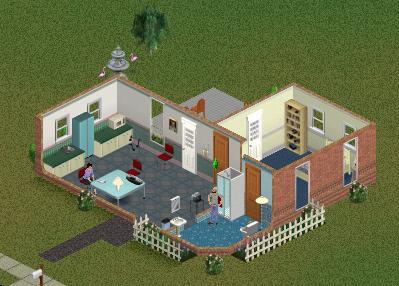
The home of the tutorial Sims, Bob and Betty Newbie
Navigation
The Main Objective
Gameplay
Simoleons
The Neighbourhood
Sub-Neighbourhoods
Expansion Packs
User Customisation
Music
Simlish
Sequels & Spin-Offs
The Mind's Rubbish Bin
Screenshots
Related Links
The Main Objective
The game's object is to create a Sim, then build a house for them and move them in, directing them to do things for as long as the player so desires. There is no real way to win or lose the game. However, some players have defined "winning" The Sims as gaining all ten skill-points in all seven fields and/or reaching the top of each career track, and "losing" as having their Sim die. Regardless, these goals are inconsequential, as gameplay will continue unaffected by the events in a single household.
Gameplay
After building and furnishing a house for your Sims, you take control of the Sims' lives. In general, there are eight basic needs that need to be met in order for a Sim to live: Hunger, Bladder, Hygiene, Comfort, Energy, Social, Fun, and Room. Each need will decay over time, based on the Sim's personality (examples: Playful Sims' Fun metres require constant attention, Sloppy Sims' Room metres require almost no attention at all). If the player allows a need to fail, more often than not, another need will begin to fail. For instance, if a Sim's Bladder need fails, they will wet themselves -- this will return the Bladder need to 100%, but it will cause Hygiene to completely fail as a result. If a Sim fails their Energy need, they will fall asleep where they stand, which, whilst restoring the Energy need, will cause the Comfort need to fail.
Hunger is the only need whose failure state is lethal. If a Sim's Hunger metre is allowed to fully deplete, they will die of starvation.
If Social or Room fails, the Sim may become uncooperative, declining to perform certain activities until their Social or Room score is raised.
Apart from fulfilling needs, another staple of Sims gameplay is Sims ability to interact, socially, with other Sims. Social interactions include friendly actions (such as talking, telling jokes, and giving compliments), mean actions (such as giving insults, slapping across the face, and fighting), and romantic actions (such as flirting, giving back-rubs, and kissing). Depending on the two Sims' personalities, there are different reactions to each socialisation -- for instance, a joke will be lost on a Serious Sim. Needs also play a role in how successful socialisation is -- in particular, hungry Sims will reject marriage proposals. However, the relationship level between two Sims is the strongest deciding force in what kind of social interactions will be met positively. For instance, a Sim has fallen in love with another Sim, but the feeling is not mutual -- when the first Sim attempts to kiss the second Sim, the action will be met by a push away, decreasing relationship points for both Sims. However, if both Sims are in love with each other, a kiss will be met positively, increasing relationship points.
Depending on what types of social interactions are used the most, Sims can become friends, best friends, enemies, or fall in love.
Hot Date introduced the most new social interactions, mostly relating to romance. Also added was the dual relationship metre, discerning between daily and long-term relationship points. Daily points are affected by recent interactions, where long-term points are affected by not only social interactions, but the frequency of socialisation.
Sims can also learn a variety of Skills: Cooking, Mechanical, Charisma, Logic, Body, and Creativity. Skills give Sims practical knowledge which they can use around the house or on the job. Cooking and Mechanical skills are the most commonly-used in the game -- high Cooking skill allows Sims to make much more Hunger-satisfying meals whilst lowering the probability of a kitchen fire. High Mechanical skill allows Sims to repair household items themselves, saving a visit from the repairman. The other skills are used, mostly, in a Sim's line of work. A Sim in the Music career will require high Creativity and Charisma, whilst a Sim in the Military needs high Body and Logic.
Simoleons
First introduced in SimCity 3000, the Simoleon (symbol: §) is the official currency of SimNation. In The Sims each new Sim family starts out with §20,000 with which to purchase a lot, build a house (if one is not present on the lot already), and furnish it. Simoleons are also spent whenever a Sim takes something from the refrigerator, though the cost varies by the item taken.
Service Sims, such as maids and repairmen, charge by the hour for their work. Also, burglars can break into a Sim's house and steal items. If a burglar alarm was purchased before the break-in, the police will be summoned and will pay the homeowner for the capture of the "wanted criminal", as well as compensatory funds if the burglar managed to nick anything before the police arrived.
Going to work is the fastest way to earn Simoleons, though Sims may also build things at a workbench or paint pictures at an easel to earn Simoleons. Occasionally, Sims will receive telephone calls, informing them of Simoleons earned from the resolution of unseen events (e.g. the settlement of frivolous litigation, a lottery pool, a bank error in the Sim's favour).
The Neighbourhood
The Neighbourhood is where you may view all of the houses you have built and enter houses or empty lots to either continue playing a family or build a new house. Create-a-Sim mode is also accessed from this screen, where the player may create Sims to eventually populate the neighbourhood. Beginning with the expansion pack, Livin' It Up, the game gives the player a choice of eight neighbourhoods in which to play. In the expansion pack, Unleashed, a new area was added to the main neighbourhood -- called "Old Town" -- which could be populated by Sims or have community lots built upon it.
Sub-Neighbourhoods
Each expansion pack after House Party (with the exception of Unleashed) introduced a new area to the game that was related to its subject matter. The first was a place called "Downtown", included in the expansion pack, Hot Date. Sims can travel to Downtown by cab to buy things, such as clothing, gifts, food items, and the like at one of many customisable commercial buildings. Downtown is also used as a place where Sims may go on dates with other Sims.
Expansion Packs
There were seven expansion packs released for The Sims. They are...
>Livin' It Up (called Livin' Large in the United States): focussed on gaudy Vegas lounge styles from the 1960s and '70s. Introduced more neighbourhoods to choose from
>House Party: focussed on Rave and Old West styles.
>Hot Date: focussed on urban and commercial atmosphere. Introduced Downtown.
>On Holiday (called Vacation in the United States): focussed on Hawai'ian and Alpine styles. Introduced Vacation Island, where Sims can go on holiday.
>Superstar: focussed on new Hollywood styles and high fashion. Introduced Studio Town, where Sims can go to become famous.
>Unleashed: focussed on New Orleans styles. Introduced Old Town, an extension of the main neighbourhood.
>Makin' Magic: focussed on Tuscan and haunted house styles. Introduced Magic Town, where Sims can go to perform magic and deal in magical sundries
User Customisation
Apart from being the first game in The Sims series, the game is most well-known for its extensive customisation ability. Using a relative few tools, users are able to alter every aspect of the game, from the outfit a Sim wears to the way the game, as a whole, behaves. In its original run, there were over 30,000 websites that dealt in customisations for The Sims. The most common items found on such websites were clothing and houses, as they were the two most-readily editable items in the game. However, a few larger websites offered elabourate character meshes, game hacks, and furnishing objects with new animations.
Although many of these websites shut down after The Sims 2 was released, a few of the larger outlets (such as The Sims Resource and SimPrograms.com) continued providing items for The Sims long after its obsolescence -- mostly due to the fact that their contributors had the necessary knowledge to also make items for The Sims 2.
Many tools existed to assist users in editing their game -- the most well-known of which was Don Hopkins's Transmogrifier, a tool that allowed users to make furnishing objects in a similar fashion to the Maxis object designers. Moreover, several of these editing tools were released by Maxis, itself -- such as SimShow, a tool which displayed a Sim so as to assist in the skin- or head-making process; and HomeCrafter, which allowed the user to import images from their computer to be used in the game as wall and floor textures.
Music
The music in The Sims was composed by Jerry Martin, Robi Kauker, Kent Jolly, Marc Russo, Kirk R. Casey, and Michael Cormier. The game's main soundtrack was divided into four areas -- jazz in the neighbourhood and in Create-a-Sim mode, new age in Build Mode, orchestral in Buy Mode, and miscellaneous styles for the stereo object.
Build Mode featured a series of new age improvisational piano solos, provided by Martin and Kauker. Buy Mode featured four orchestral pieces based on 1950s orchestral music. Two songs were composed by Martin, and the others by Cormier and Casey.
The neighbourhood music consisted, mainly, of jazz music, composed by Russo. However, The Sims's main theme (entitled, "The Neighbourhood"), which was composed by Martin, was featured also.
The game's stereo object featured several different genres of music, including rock, jazz, and bluegrass. This music was written, primarily, by Kauker. However, the "Classical" radio station contained piano renditions of pieces composed by Wolfgang Amadeus Mozart, Ludwig von Beethoven, and Johann Sebastian Bach.
The in-game piano object featured short clips of piano music, played by persons of varying skill levels. The more complex pieces were performed by Robi Kauker, either improvising or playing an existing piece.
Each expansion pack contained new music, either for the new neighbourhood area or for the stereo. Included in the expansion pack, Hot Date, were two types of public announcement speakers, over which different types of music would play. Over the least expensive of the two speakers played 1970s elevator music, over the most expensive played a string quartet rendition of pieces written by various classical composers.
In Unleashed, Build and Buy Mode on Old Town commercial lots featured Creole Zydeco, whilst development of unoccupied residential lots featured the same music set used in Hot Date's Downtown area.
Superstar was the first to use stock music in a primary location, as various pieces of 1950s-era "Hollywood" music play in Studio Town view (Hot Date's speaker objects played stock music, but this music only played when the objects were present on a lot). However, lot development featured new techno music, composed specifically for the game by the Canadian group, the Humble Brothers (they would later go on to write some of the Mayor Mode soundtrack to SimCity 4).
Simlish
Simlish is the language spoken by Sims. Though many players have attempted English translations of Simlish words and phrases, the language consists mainly of gibberish. There were three initial voice actors who provided Simlish for The Sims -- Gerri Lawlor (female Sims), Stephen Kearin (male Sims), and Sean O'Connor (child Sims). They viewed the Sims' animations on a monitor in the recording studio, and then provided impromptu Simlish phrases to go with the situation.
Each new expansion pack introduced new characters, increasing the number of voice actors. A few of the Maxis staff were among the voices heard in-game, most notably the game's executive producer, Tim LeTourneau, and the game's creator, Will Wright.
The House Party expansion pack added a celebrity voice to the roster with Drew Carey, whose likeness was also used in-game.
Sequels & Spin-Offs
As was stated previously, The Sims was the beginning of a long line of people simulators by EA Games, spawning two sequels and several spin-offs and console ports.
The Sims Online, released 17 December 2002, was a massively multiplayer online game based on The Sims's game engine. Drawing less than 100,000 players over its entire life-span, this was the least successful of The Sims spin-offs. It was also the most controversial in the series, as a group of industrious players had been able to take advantage of the game's programming to create prostitution and a kind of mafia. The Sims Online became known as EA-Land in March of 2007, but continued to suffer mediocre playership and was completely shut down on 1 August 2008.
The Sims for consoles (sometimes referred to as The Sims: Get a Life), released 23 March 2003, was the first console port. Its gameplay was very similar to its PC counterpart, but implementing an RPG-like story mode alongside the usual sandbox mode. In an unusual marketing move, this port was released on the Sony PlayStation 2 several months before being ported to the Nintendo GameCube and Microsoft Xbox.
The Sims: Bustin' Out, released 16 December 2003, was the second console port. It featured an expanded story mode, allowing Sims to visit other locations at will and complete tasks set forth there. Bustin' Out was also the first Sims game to be made for a handheld console (i.e. the Nintendo Game Boy Advance). The handheld version of Bustin' Out was compatible with the GameCube version, allowing players to send their GameCube story mode Sims to the Game Boy Advance and back again.
The Sims 2, released 14 September 2004, was the first sequel to The Sims. This was also the first fully 3D game for the PC in the Sim franchise, as opposed to the top-down isometric view and dimetric projection
of past titles. Gameplay was expanded by giving Sims life aspirations, with a set of wants and fears to fulfill. Sims were also given full lifespans, allowing players to create Sim dynasties by carrying on the family lineage throughout infinite generations. Eight expansion packs were released for this game, as well as nine "stuff packs" (themed collections of hairstyles, clothing, and furnishing objects). The Sims 2 ran for five years and had eight expansion packs released for it before being succeeded by The Sims 3 in June 2009.
The Urbz: Sims in the City, released 9 November 2004, was a relatively unsuccessful spin-off of The Sims. Taking place in SimCity's various districts, the object of the game was for Sims to gain as much of a reputation for themselves as possible. The musical group, The Black-Eyed Peas, made appearances in the game, as well as having done Simlish renditions of a number of their songs, which served as the game's background music. An RPG-version of this game was also released for Nintendo's handheld consoles, the Game Boy Advance and Nintendo DS.
The Sims 2 for consoles, released 25 October 2005, drew much of its gameplay from its PC counterpart, inasmuch as it had a similar aspirational system, however it did not allow Sims to age as the PC version did. This was the first game in The Sims console series where the Sim characters, themselves are directly controllable by the player using the control stick to move Sims about, rather than moving a cursor to select items.
The Sims 2: Pets for consoles, released 17 October 2006, was based on the expansion pack for The Sims 2 by the same title. Apart from omitting story mode and adding cat and dog Sims, gameplay was nearly identical to its console predecessor.
The Sims Castaway, released 23 October 2007, is unique in The Sims series, in that it is less of a people sim and more of a survival sim, as your character has washed ashore on a deserted island following an accident of some sort.
MySims, released 18 September 2007, was released only on Nintendo DS and Wii. Gameplay is centred around building houses and furnishing objects in a quest to rebuild the player's character's town. Simplifying this game for younger audiences, needs, aspirations, and simoleons were not included. On 28 October 2008, MySims was released for PC-CD. MySims has become its own mini-series, with new titles added to the label regularly. MySims titles include Kingdom, Party, Racing, and Agents.
The Sims 3, released 2 June 2009, is the second and most current sequel to The Sims. Gameplay has been expanded by including the rest of the neighbourhood into normal gameplay, allowing Sims to travel around town at will. Also notable is the user's ability to edit objects, clothing, and building materials entirely in-game.
The Mind's Rubbish Bin
The Sims series is the most successful of the entire Sim franchise, grossing over $5,000,000,000. The Sims Original unseated Myst as the best-selling computer game a year after release.
There is some debate between critics about whether The Sims has truly outsold Super Mario Bros. Whilst it is true that the latter only sold 40,000,000 physical game cartridges, The Sims is part of a series of games, which, collectively, have sold over 100,000,000 copies. However, between 2000 and 2005, The Sims Original sold almost 20 million copies (base game, expansion packs, and software anthologies, combined), falling short of Super Mario Bros. by nearly half. Thus far, neither The Sims 2 nor The Sims 3 have been able to match Mario in sales. Some critics argue that Super Mario Bros. is still the highest-selling individual game in the history of electronic gaming. Regardless, the Super Mario series, as a whole, remains unrivalled in total sales (garnering over ten multi-million-sellers in the series proper, alone).
The game has been called the most customisable game in the history of videogaming. During the height of The Sims Original's success, there were over 30,000 websites that dealt in custom content for the game.
Will Wright had been toying with the idea of a people simulator since the release of the first SimCity in 1989. Citing the Commodore 64 game, Little Computer People, as a precedent, he attempted to sell the idea to Broderbund (Maxis' publisher at the time) with no success. In 1996, however, Electronic Arts gave Wright's idea the green light, allowing Maxis to begin development on what was then called "Project X". The game went through several potential titles, including "DollHouse". It was released as "The Sims" on 4 February 2000.
One of Will Wright's principal inspirations for the game was his own experience with a house-fire. Partly because of this, in-game fires cannot travel through walls and spread to other rooms.
The Sims began the tradition among Sim games of displaying meaningless loading text-strings. The loading text would change with each new expansion pack, often with the text conveying some sort of message about the content of the expansion. This is the second game in the Sim franchise to display the nonsense message, "Reticulating Splines" (the first being SimCity 2000).
After a single Sim family has been played for one hundred game days, a series of "Did You Know?" prompts appear, providing the player with trivial information. One of these will appear every consecutive game day after day 100 until there is no more trivia. This feature was not discovered until 2003.
The geometric shape which hovers over the head of a currently-selected Sim was nicknamed the "Plumb-Bob", after the carpentry tool which checks a structure for plumb (straightness), due to its constant upright position. This name was somehow leaked into the community, where it became the unofficial name for the shape. It now serves as the The Sims series' primary logo and has appeared in every release since The Sims Original. The shape itself is a dodecadeltahedron (hexagonal bipyramid -- in The Sims 2 for Nintendo DS, however, the shape is based on a square, rather than a hexagon).
A beta "plumb-bob" can be seen in the opening video on The Sims through House Party which more closely resembles an arrow.
There was a user-made modification for the game known to the community as the "nude patch", which would remove the censor boxes from nude Sims. As Sims, by default, are not anatomically correct, some variants of this mod would also add anatomy features to them. The "nude patch" was the most-downloaded custom feature for The Sims. Its existence caused former Florida prosecutor, Jack Thompson (notorious in the gaming community for taking offence at small problems in videogames, then suing the developer) to sue Electronic Arts for indecency. The case was later dropped. The "nude patch" caused such a stir that Maxis made a reference to it in a loading text-string in SimCity 4 ("Pixellating Nude Patch"). "Nude patch" is now used as an umbrella term among the videogaming community, meaning any user-created modification to a game that makes it possible for the characters to display nude, sometimes anatomically correct.
Gameplay is based largely on Maslow's Hierarchy of Needs. Abraham Maslow theorised that all humans have a collective set of needs which must be met in order to live up to one's potential. Socialising in The Sims is based on the need for love and belonging. The "Hunger", "Energy", and "Bladder" motives are based on the physiological needs. Skill-building, whilst not a "need", per se, is based on the need for self-actualisation. Whilst the needs for self-esteem and personal security were mostly ignored by The Sims Original (probably due to technical constraints on the game's AI), The Urbz and The Sims 2 explored these needs in greater detail (the entire purpose of The Urbz is based on self-esteem).
The soundtrack to Makin' Magic, the final expansion pack for the game, was not composed specifically for it. The music comes from the APM Music Library.
In October 2010, The Sims' original website was shut down. Its URL now directs users to The Sims 3 website.
In 2007, there was talk of The Sims being adapted into a film -- however, no further news on this point was ever released. The project is assumed to have been abandoned.
Screenshots
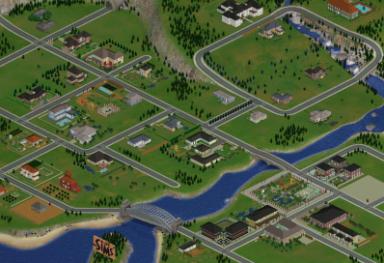
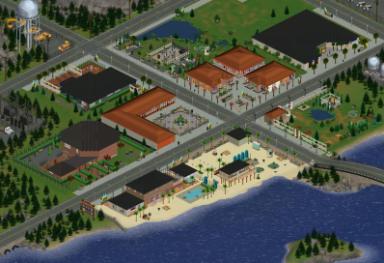
The main neighbourhood screen with Unleashed's Old Town (left) and Hot Date's Downtown area (right).
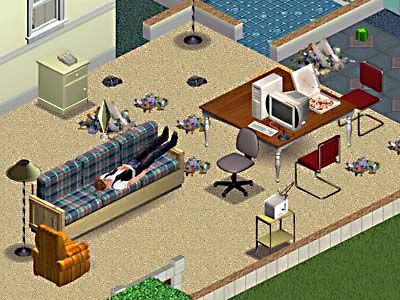

A comparison of the beta game (left) and the actual release (right). In the beta screenshot, note the atypical reclining posture of the Sim, the white television, the odd circular shadows under the floor-lamps, the square shadow under the office chair, and the unusual wall-cutaway near the doors.

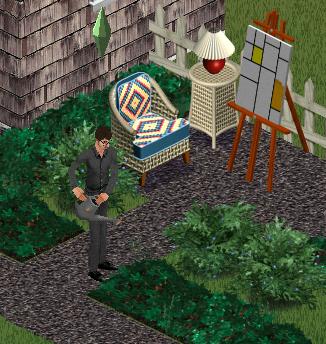
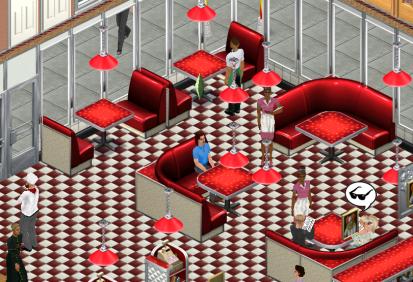
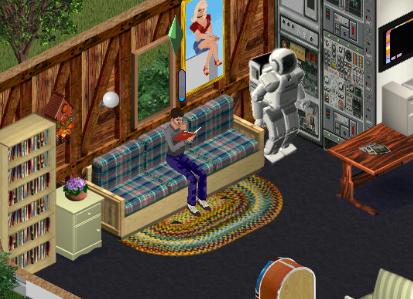
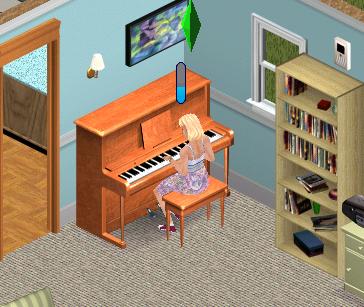
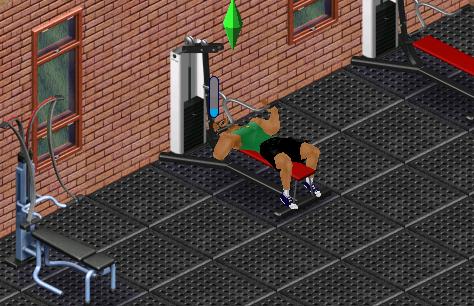
Some Sims living their lives.
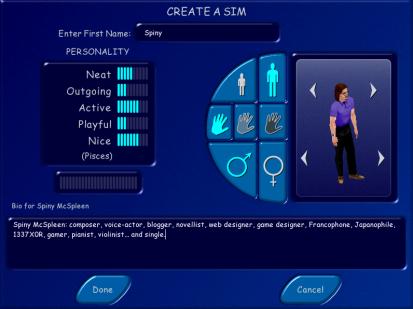
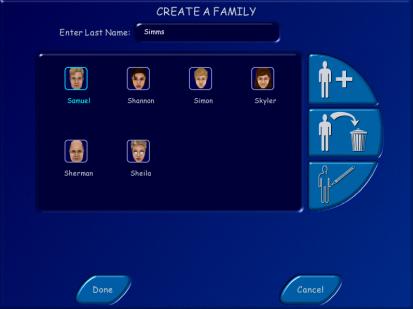
The "Create A Sim" screen allows players to make the individual family members. Family members are shown in the "Create A Family" list.
Related Links
The Sims' E3 Trailer/Opening Video
"The Sims" on Wikipedia
"The Sims" on MobyGames
"The Sims" on GameFAQs
Wikia: The Sims
Spiny McSpleen's Nifty SimCity 4 Webpage
The Sims 2 Official Website
MySims Official Website
HOME
The Sims and all related indicia, Copyright © 2000-2010 Electronic Arts, Inc.
Page coding and layout by J. Sebastian Perry (a.k.a. Spiny McSpleen)
















